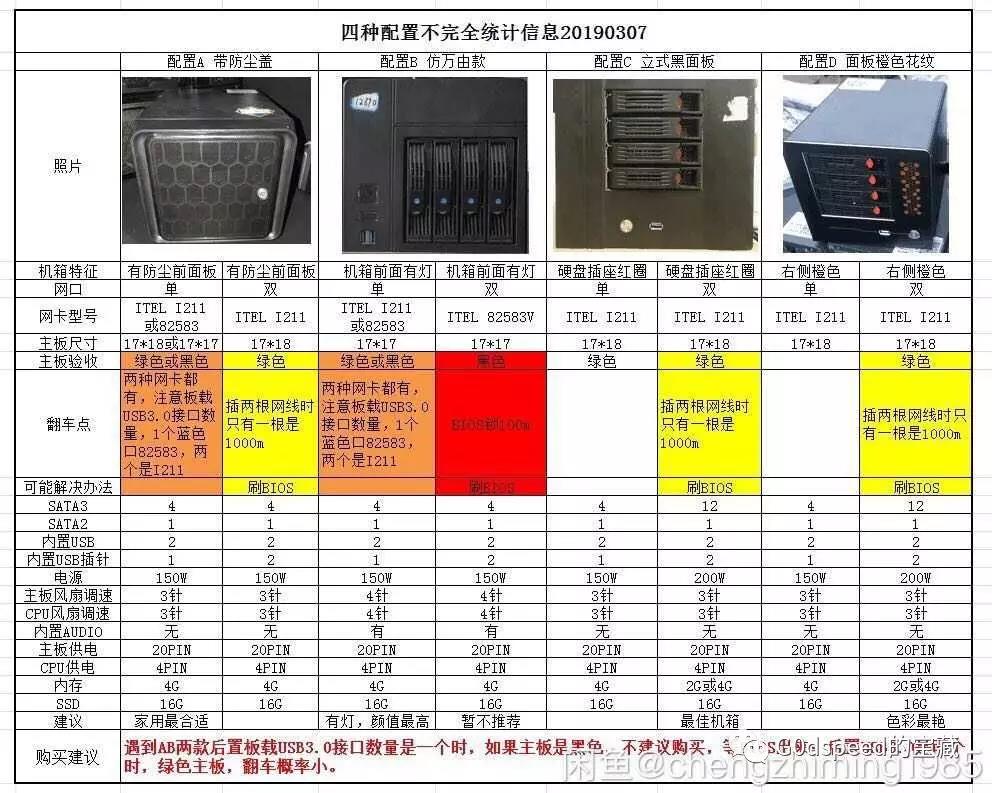突然发现网站不能访问了,虽然访问量不大。但是毕竟也是维护了多年的心血。还是给它重新找一个家吧。
翻了半天,找到一个新的VPS – UpCloud。 测了一下,速度还不错哦。有点DigitalOcean一开始的感觉。
试用了几天,感觉不错,搬!
现在它还有Referral Program. 通过下面这个Link来注册的话,你就会有$25的Credit。不错吧?
突然发现网站不能访问了,虽然访问量不大。但是毕竟也是维护了多年的心血。还是给它重新找一个家吧。
翻了半天,找到一个新的VPS – UpCloud。 测了一下,速度还不错哦。有点DigitalOcean一开始的感觉。
试用了几天,感觉不错,搬!
现在它还有Referral Program. 通过下面这个Link来注册的话,你就会有$25的Credit。不错吧?
最近矿难,一大批名为”蜗牛星际”的“矿机”在咸鱼上甩卖。配置为4-Bay的NAS机箱,Intel J1900的CPU,4G内存,16G的msata SSD。此配置如果从马云家拿散件的话,价格在800+。但是这个蜗牛星际只要300就可以搞定了。完全就是买机箱送CPU+主板+内存+SSD啊!刚好一直想组一个家用NAS,于是立马就上车了。
“蜗牛星际”目前有A、B、C、D四款机型,每款机型又分单网卡的和双网卡的。具体配置见下图:

本着颜值最高选了B款,但是又不甘心单网卡。于是就选择了“暂不推荐”的B双网卡版。让卖家发了德邦物流,还挺快,没几天就到家了。
这几天又用到这个命令,Mark一下。
find ./someDir -name “*.php” -o -name “*.html” | tar -cf my_archive -T –
可以把目录下面的同一类型文件全部打包
Refer: http://triplescomputers.com/blog/uncategorized/solution-switch-windows-10-from-raidide-to-ahci-operation/
更新至 2018/10
| Provider | Primary DNS Server | Secondary DNS Server |
|---|---|---|
| Level31 | 209.244.0.3 | 209.244.0.4 |
| Verisign2 | 64.6.64.6 | 64.6.65.6 |
| Google3 | 8.8.8.8 | 8.8.4.4 |
| Quad94 | 9.9.9.9 | 149.112.112.112 |
| DNS.WATCH5 | 84.200.69.80 | 84.200.70.40 |
| Comodo Secure DNS | 8.26.56.26 | 8.20.247.20 |
| OpenDNS Home6 | 208.67.222.222 | 208.67.220.220 |
| Norton ConnectSafe7 | 199.85.126.10 | 199.85.127.10 |
| GreenTeamDNS8 | 81.218.119.11 | 209.88.198.133 |
| SafeDNS9 | 195.46.39.39 | 195.46.39.40 |
| OpenNIC10 | 69.195.152.204 | 23.94.60.240 |
| SmartViper | 208.76.50.50 | 208.76.51.51 |
| Dyn | 216.146.35.35 | 216.146.36.36 |
| FreeDNS11 | 37.235.1.174 | 37.235.1.177 |
| Alternate DNS12 | 198.101.242.72 | 23.253.163.53 |
| Yandex.DNS13 | 77.88.8.8 | 77.88.8.1 |
| UncensoredDNS14 | 91.239.100.100 | 89.233.43.71 |
| Hurricane Electric15 | 74.82.42.42 | |
| puntCAT16 | 109.69.8.51 | |
| Neustar17 | 156.154.70.1 | 156.154.71.1 |
| Cloudflare18 | 1.1.1.1 | 1.0.0.1 |
| Fourth Estate19 | 45.77.165.194 | |
| CleanBrowsing20 | 185.228.168.9 | 185.228.169.9 |
Refer: https://www.lifewire.com/free-and-public-dns-servers-2626062
这几天发现好多HEVC的视频居然在Win10 Explorer里面没有缩略图,一查才发现居然Win10没有自带HEVC解码器。
到微软商店一搜,HEVC Video Extensions,居然还要卖钱。微软真是…. 都不知怎么形容了。
网上搜了下,发现其实微软商店里面还有个HEVC Video Extensions from Device Manufacturer。这个是免费的,而且功能一模一样。
额… 还能说什么呢…
今天在研究Linux下增量备份的时候,发现了一个非常Genius的命令。
用这个命令即可以做到增量备份,又可以最少量的占用硬盘空间。
rm -rf backup.3
mv backup.2 backup.3
mv backup.1 backup.2
cp -al backup.0 backup.1
rsync -a --delete source_directory/ backup.0/
多的懒得写了,大家自己体会吧。:D
Refer:http://www.admin-magazine.com/Articles/Using-rsync-for-Backups/
最近因转换视频格式需要,研究了一下目前的视频格式转换工具。
发现下面几个比较顺手的:
一年一度的Airshow,纠结了一下还是出发了~
推荐两个Partition Magic的替代软件
可动态调整分区大小,分区,格式化什么的就更不在话下了。
PS:如果你用SSD的话,记得分区对齐。